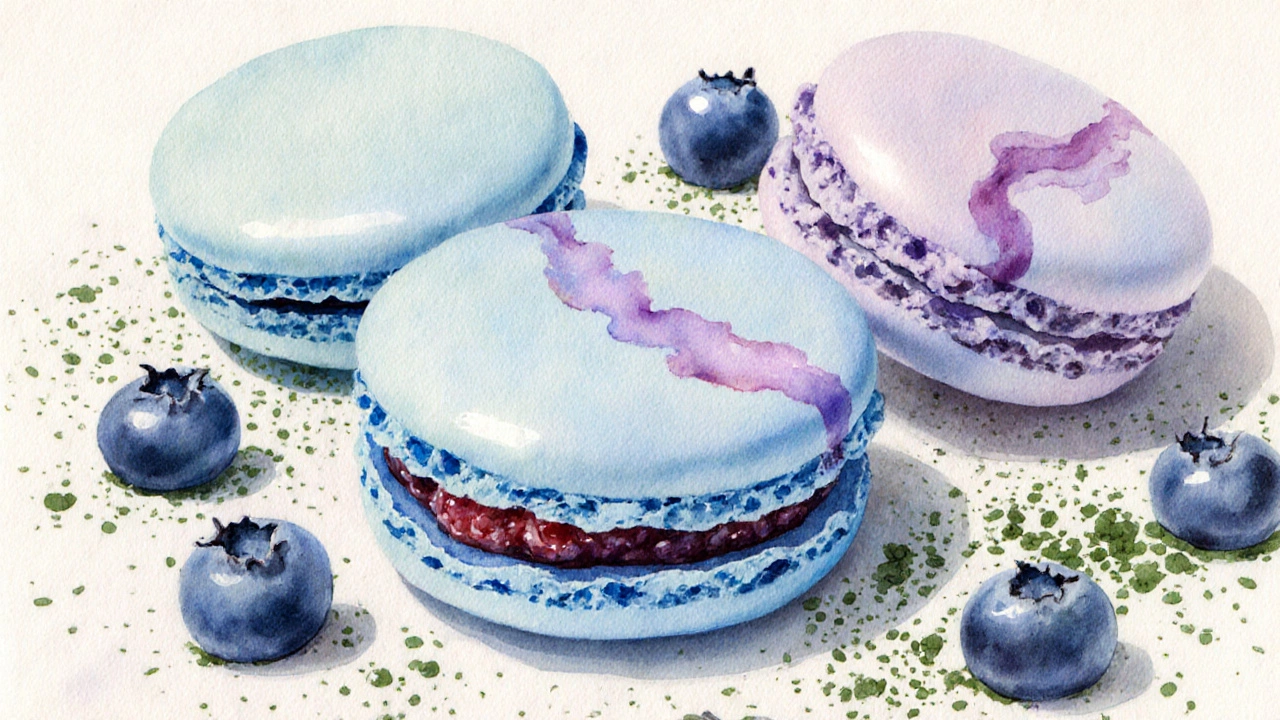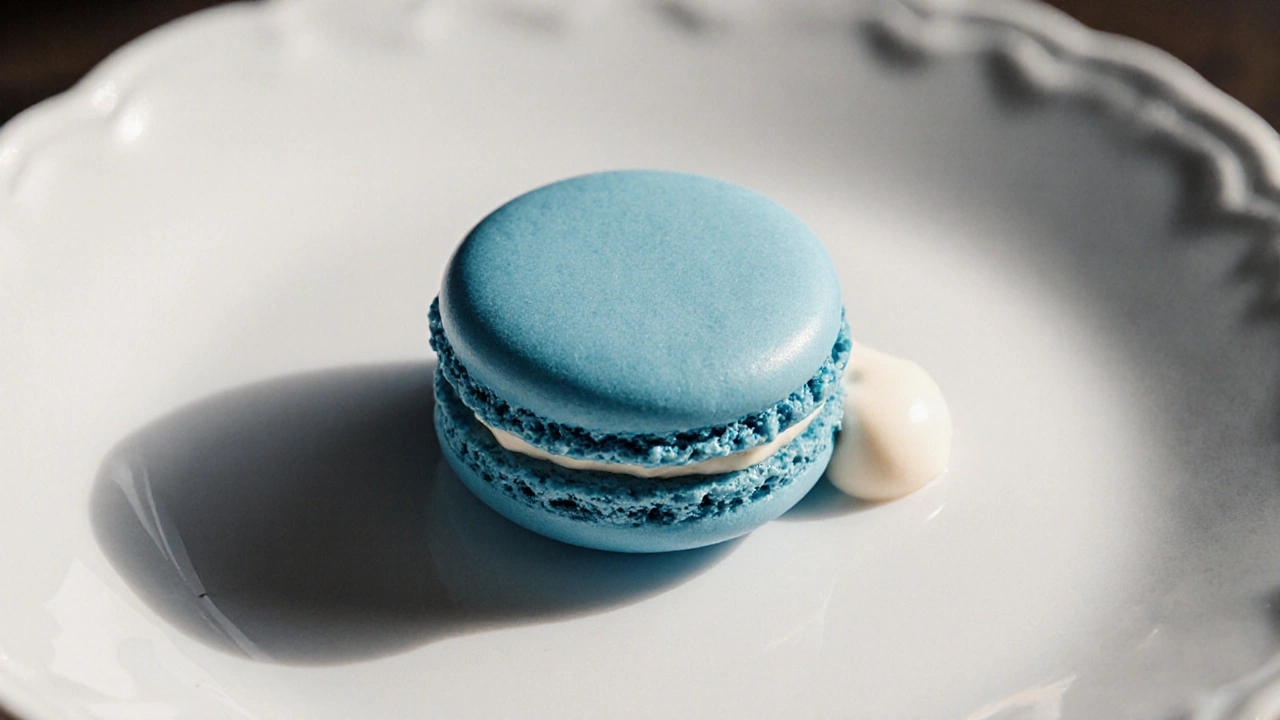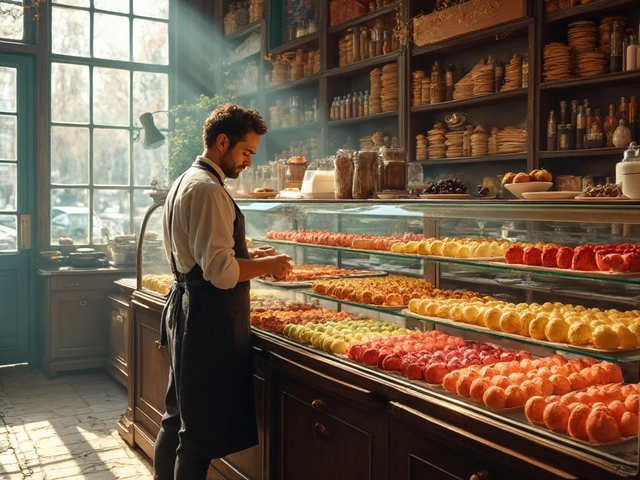Blue Macaron Flavor Predictor
Color doesn't equal flavor. A blue macaron shell could contain vanilla, lemon, raspberry, or lavender filling. Test your knowledge and learn why you shouldn't guess flavors by color!
Guess the Flavor
What's Inside:
Ever bitten into a bright blue macaron and wondered, what does it actually taste like? That vivid color makes you expect something wild-maybe bubblegum, maybe cotton candy, maybe even a weird chemical aftertaste. But here’s the truth: the color doesn’t tell you the flavor. A blue macaron could taste like vanilla, lemon, pistachio, or even lavender. It’s all in the filling.
Color doesn’t equal flavor
Macarons are often dyed with food coloring to look like rainbow clouds, but the shell itself is nearly flavorless. The real taste comes from the buttercream, ganache, or jam inside. A blue shell might hold a creamy vanilla filling, or it could be hiding a tart raspberry puree. Some bakers use blue spirulina for natural color, which adds a faint sea breeze note. Others use synthetic dyes with zero flavor impact. You can’t guess the taste by looking at it.
That’s why professional bakers label their macarons. If you’re buying from a shop and see a blue one with no tag, ask. Don’t assume. I’ve seen people take one bite of a blue macaron expecting blueberry, then spit it out because it was coconut. The shock isn’t just disappointment-it’s confusion. You trusted the color. But macarons don’t work that way.
Common flavors hidden in blue shells
Here’s what you’re most likely to find inside a blue macaron:
- Vanilla bean - The classic. Creamy, sweet, clean. Often paired with blue for a calming contrast.
- Lemon curd - Bright, tangy, and refreshing. The blue shell makes it look like a summer sky.
- Raspberry - Tart, fruity, and vivid. The red filling shows through the thin shell, creating a purple-blue swirl.
- Coconut - Sweet, tropical, with a hint of nuttiness. Sometimes mixed with white chocolate ganache.
- Lavender - Floral, subtle, elegant. Often paired with honey or vanilla. The blue color enhances the dreamy vibe.
- Blueberry - Less common, but real. Made with real blueberry puree, not just dye. It’s sweet but not artificial.
Some bakers get creative: blue matcha (earthy, slightly bitter), blue cheese (yes, really), or even blue mint chocolate. The flavor possibilities are endless. The shell is just a canvas.
Why do people dye macarons blue at all?
It’s mostly about mood and marketing. Blue is calming. It’s associated with the sky, the ocean, serenity. In weddings, baby showers, or spa-themed events, blue macarons feel elegant and soothing. They stand out in a tray of pastels. They’re Instagram-ready.
But there’s also tradition. In France, where macarons were perfected, bakers used natural ingredients for color-beet juice for red, spinach for green. Blue was rare because natural blue pigments were hard to find. Today, synthetic dyes make it easy. So blue macarons aren’t traditional-they’re modern. They’re made to catch your eye, not to follow rules.

Can you make a blue macaron taste like blueberry?
Yes, but it’s harder than you think. Blueberry flavor is delicate. If you use extract, it tastes like medicine. If you use jam, it can make the filling too wet and ruin the texture. The best way is to reduce fresh blueberries into a thick, concentrated puree, then mix it into buttercream or ganache. It takes time. You need to cook off the water, strain the seeds, and balance the sweetness.
Most commercial blue macarons don’t do this. They use artificial blueberry flavoring-chemicals that mimic the taste without the fruit. It’s cheap, fast, and strong. But if you’ve ever tasted real blueberries, you’ll know the difference. Real blueberry macarons have depth. They taste like summer. The fake ones taste like candy.
How to taste a blue macaron the right way
Don’t rush it. Here’s how to really experience one:
- Look at it first. Notice the texture-the smooth shell, the ruffled edge, the slight sheen.
- Smell it. Is there vanilla? Citrus? Flowers? The scent will give you the first clue.
- Take a small bite. Let the shell crack gently. Don’t crush it.
- Let the filling melt on your tongue. Swirl it around. Is it creamy? Tangy? Nutty?
- Wait a second. Notice the aftertaste. Does it linger? Is it clean, or does it leave a chemical afterburn?
That’s how you tell if it’s good. Not by the color. Not by the price. By how it feels in your mouth.

What to avoid
Stay away from blue macarons that:
- Smell like plastic or perfume
- Leave a sticky, artificial film on your tongue
- Have a gritty texture (sign of poor almond flour or too much dye)
- Are overly sweet without any balance
These are signs of mass-produced, low-quality macarons. They’re made for looks, not taste. Real macarons should be delicate. They should melt. They should surprise you-not shock you.
Try this at home
If you want to make your own blue macaron with real flavor, start simple. Use a basic vanilla filling and add a few drops of blue spirulina powder. It’s natural, mild, and won’t overpower. Or try this: mix 1 tablespoon of blueberry puree (reduced to syrup) into 1/2 cup of whipped buttercream. Pipe it into shells, let them rest overnight, and bake. The result? A macaron that looks like the sky and tastes like fruit.
Don’t worry if the color fades a little. That’s normal. Natural dyes do that. It doesn’t mean it’s bad-it means it’s real.
Final thought: Taste, don’t assume
A blue macaron isn’t a flavor. It’s a promise. The promise that something beautiful is hiding inside. Don’t judge it by the outside. Don’t let the color trick you. The best macarons don’t scream-they whisper. And when you finally taste them, you’ll understand why people keep coming back.





